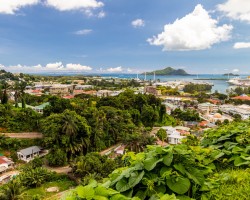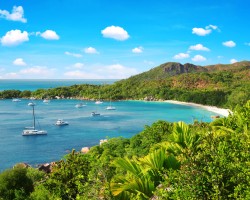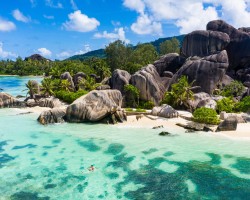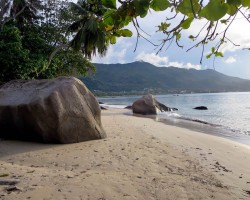Best time to go to the Seychelles for a perfect weather and where to go?
When is the best time to go to the Seychelles?
The Seychelles, which can be visited all year round, are particularly pleasant during the months of June, July, and August. Indeed, it is during this period that precipitation is at its lowest within the archipelago. Temperatures are also slightly cooler, ranging between 27 and 29 °C. Therefore, this is the best time to visit the Seychelles. Moreover, this season is ideal for beach holidays as there are many sunny days and an ideal sea temperature.
However, as it coincides with school holidays, one should expect a large influx of tourists. Furthermore, prices tend to increase, so it is advisable to book your trip well in advance.
On the other hand, if you are looking for the best time to visit the Seychelles to avoid crowds, the shoulder seasons can be a good idea. You can enjoy pleasant weather conditions and more advantageous offers. For this, plan your trip between September and November or March-April, at the beginning and end of the wet season. This period, although less touristy, includes some important cultural events such as the "Creole Festival" held annually in October.
Finally, during the rest of the year, be prepared to face high temperatures and regular rainfall. For these reasons, December and January are months better avoided for traveling to the Seychelles.
Annual weather in Seychelles
For information about the climate and the weather city by city in Seychelles for a specific month, click on the corresponding line below:
| Month | Our opinion | View Details | |||
|---|---|---|---|---|---|
| January | 28°C to 29°C | tolerable weather | |||
| February | 28°C to 29°C | tolerable weather | |||
| March | 29°C | good weather | |||
| April | 29°C | good weather | |||
| May | 27°C to 29°C | tolerable weather | |||
| June | 26°C to 28°C | good weather | |||
| July | 25°C to 27°C | good weather | |||
| August | 25°C to 27°C | good weather | |||
| September | 25°C to 27°C | good weather | |||
| October | 26°C to 28°C | good weather | |||
| November | 27°C to 29°C | good weather | |||
| December | 29°C | tolerable weather |
Best time to travel to Seychelles by cities
Climate and Weather in Seychelles
With high yet pleasant temperatures and an average of about seven hours of sunshine per day, the Seychelles experience idyllic weather almost all year round. Indeed, this archipelago, neighboring Madagascar and Mauritius, represents a little paradise that captivates many travelers.
The climate of the Seychelles is equatorial. Due to the islands' proximity to the Equator, the weather shows little variation throughout the year. The temperatures remain constant, fluctuating only by 3 or 4 degrees. Showers are common, although the sun predominantly shines over the archipelago. The sea temperature is also ideal for swimming, thanks to a closed lagoon where the water quickly warms up.
There are two distinct seasons on the islands, determined by the direction of the trade winds:
- The dry and cool season lasts from June to September, influenced by the southeast trade winds.
- The rainy season or hot season extends from October to April-May, influenced by the northwest trade winds.

Seychelles Climate: Dry Season
During the dry season in the Seychelles, you can expect sunny weather, perfect for your holidays. Temperatures range between 27 and 31 °C on average, with the water temperature around 27 °C. Moreover, the presence of regular winds helps make the atmosphere more pleasant. This somewhat windy season is a delight for watersports enthusiasts. From June to September, temperatures remain constant, although they may slightly drop in the evenings.
However, it is important to note that some showers may occur during this period. Although they are short-lived, they might surprise you occasionally in the late afternoon or at night.
Seychelles Climate: Wet Season
The rainy season is characterized by an increase in precipitation and temperatures. Indeed, temperatures range between 28 and 32 °C on average, with a heavier atmosphere that can be challenging to bear.
Rainfall is regular from November to May. Even though the weather is rainy for 21 days out of 30 in some months, the precipitation usually comes in the form of passing showers. Most of them occur at night.
Moreover, if you travel during this period, be aware that the weather can vary significantly from one region of the island to another. Thus, you may have the chance to quickly find the sun again if one side of the island gets cloudy.
Furthermore, the Seychelles are located outside the cyclone zone that affects the Indian Ocean from November to April. This provides the archipelago with a certain level of safety and helps avoid severe weather conditions (storms, thunderstorms).
Although the weather may not always be ideal, the wet season is quite popular in the archipelago, especially towards the end of the year.
Seychelles Climate: Interseasons
The beginning and end of the wet season vary slightly from one year to another. However, the months of April and November are generally considered a transition period between the two seasons. The months of March, May, and October may also be affected depending on the year.
During this period, winds are less prevalent, making the heat more intense. April and May are the hottest months, which is why they are sometimes not recommended for travel. Indeed, temperatures can regularly rise to 32 °C.
However, the interseason is the ideal period for scuba diving. With less wind, the sea is calmer and visibility becomes excellent.
Finally, during these months, precipitation may occur but is less significant than during the rainy season.
Seychelles Geography: Different Climates
The Seychelles archipelago consists of over a hundred islands and atolls covering an extensive area of the Indian Ocean. Although the climate is quite similar from one island to another, there are some specificities.
Indeed, the Seychelles islands are divided into two groups:
- The inner islands, in the north, include notably the islands of Mahé, Praslin, and La Digue.
- The outer islands, in the southwest, are atolls, less populated and flatter.
The northern islands experience a rainier climate than the south. Mahé, in particular, is the rainiest island. In contrast, the Aldabra islands receive little precipitation throughout the year.
In conclusion, the Seychelles weather is favorable for travel almost all year round. However, be prepared to experience some showers and enjoy the prevalent heat.
Temperatures and rainfall in Seychelles
On these 3 graphs, we present the evolution of temperatures of Seychelles and month-by-month rainfall for the cities of Victoria (Mahé), Praslin, Aldabra, Anse Aux Pins and Anse Boileau, as well as the month-by-month sea temperature for coastal cities.
Peak visitor numbers and tourist seasons in Seychelles
Find out when Seychelles has its high tourist season (the period when the influx of tourists is highest) and off-peak tourist season using our data and figures.
Tourist seasons in Seychelles
The months with low numbers of tourists are: January, February, March, April, May, June and July. The number of visitors to Seychelles is high in: August, September, October, November and December.
- Very low season in Seychelles: January, February, March, May and June.
- Low season in Seychelles: April and July.
- High season in Seychelles: September and November.
- Peak season in Seychelles: August, October and December.
Figure: Visitor index for Seychelles month by month
Average price for flights to the Seychelles
A return flight between London and Victoria (Mahé) is generally cheaper if you go in march ($ 800 on average): this is the best time for travellers on a tight budget. In contrast, you may end up paying $ 447 more for your airline ticket to Victoria (Mahé) if you go in august.
Find the best price for your flight Flight prices to the Seychelles
Where to go in Seychelles?
This table allows you to see the maximum temperature for each city and our opinion on the weather month by month (see colour legend below the table).
| Cities | jan. | feb. | mar. | apr. | may | jun. | jul. | aug. | sep. | oct. | nov. | dec. |
| Victoria (Mahé) | 28°C | 29°C | 29°C | 30°C | 29°C | 28°C | 27°C | 27°C | 27°C | 28°C | 29°C | 29°C |
| Praslin | 28°C | 29°C | 29°C | 30°C | 29°C | 28°C | 27°C | 27°C | 27°C | 28°C | 29°C | 29°C |
| Aldabra | 29°C | 29°C | 29°C | 29°C | 28°C | 27°C | 26°C | 25°C | 26°C | 27°C | 28°C | 29°C |
| Anse Aux Pins | 28°C | 29°C | 29°C | 30°C | 29°C | 28°C | 27°C | 27°C | 27°C | 28°C | 29°C | 29°C |
| Anse Boileau | 28°C | 29°C | 29°C | 30°C | 29°C | 28°C | 27°C | 27°C | 27°C | 28°C | 29°C | 29°C |
| Anse Georgette | 28°C | 29°C | 29°C | 30°C | 29°C | 28°C | 27°C | 27°C | 27°C | 28°C | 29°C | 29°C |
| Anse Intendance | 28°C | 29°C | 29°C | 30°C | 29°C | 28°C | 27°C | 27°C | 27°C | 28°C | 29°C | 29°C |
| Anse Lazio | 28°C | 29°C | 29°C | 30°C | 29°C | 28°C | 27°C | 27°C | 27°C | 28°C | 29°C | 29°C |
| Anse Major | 28°C | 29°C | 29°C | 30°C | 29°C | 28°C | 27°C | 27°C | 27°C | 28°C | 29°C | 29°C |
| Anse Royale | 28°C | 29°C | 29°C | 30°C | 29°C | 28°C | 27°C | 27°C | 27°C | 28°C | 29°C | 29°C |
| Anse Soleil | 28°C | 29°C | 29°C | 30°C | 29°C | 28°C | 27°C | 27°C | 27°C | 28°C | 29°C | 29°C |
| Anse Source d’Argent | 28°C | 29°C | 29°C | 30°C | 29°C | 28°C | 27°C | 27°C | 27°C | 28°C | 29°C | 29°C |
| Anse Volbert | 28°C | 29°C | 29°C | 30°C | 29°C | 28°C | 27°C | 27°C | 27°C | 28°C | 29°C | 29°C |
| Baie Ste Anne | 28°C | 29°C | 29°C | 30°C | 29°C | 28°C | 27°C | 27°C | 27°C | 28°C | 29°C | 29°C |
| Beau Vallon | 28°C | 29°C | 29°C | 30°C | 29°C | 28°C | 27°C | 27°C | 27°C | 28°C | 29°C | 29°C |
| Bird Island | 28°C | 29°C | 29°C | 30°C | 29°C | 28°C | 27°C | 27°C | 27°C | 28°C | 29°C | 29°C |
| Cap Ternay | 28°C | 29°C | 29°C | 30°C | 29°C | 28°C | 27°C | 27°C | 27°C | 28°C | 29°C | 29°C |
| Curieuse Island | 28°C | 29°C | 29°C | 30°C | 29°C | 28°C | 27°C | 27°C | 27°C | 28°C | 29°C | 29°C |
| Denis Island | 28°C | 29°C | 29°C | 30°C | 29°C | 28°C | 27°C | 27°C | 27°C | 28°C | 29°C | 29°C |
| Desroches | 28°C | 29°C | 29°C | 30°C | 29°C | 28°C | 27°C | 27°C | 27°C | 28°C | 29°C | 29°C |
Legend:
good weather
tolerable weather
About Seychelles
What can I do in Seychelles?
Beaches / swimming
Nature and countryside
Culture and heritage
Sports
Family travel
Crafts / shopping
Gastronomy
Nightlife
Is this weather information for Seychelles reliable?
Climate data for Seychelles has been gathered every day since January 2009. The analysis of these meteorological data for Seychelles allows us to determine the average for each month in Victoria (Mahé), Praslin, Aldabra, Anse Aux Pins, Anse Boileau, Anse Georgette, Anse Intendance, Anse Lazio, and 25 other cities.
So yes: this data is reliable except in cases of temporary climate disruption in the region.



